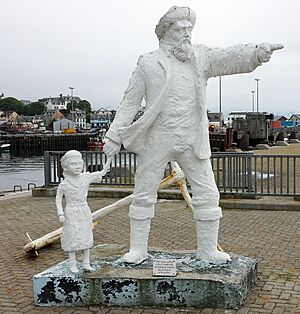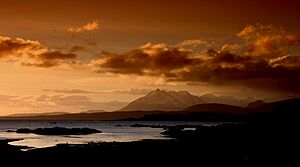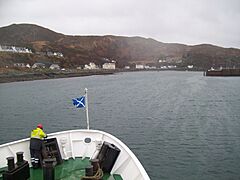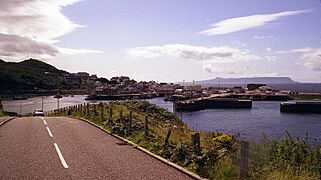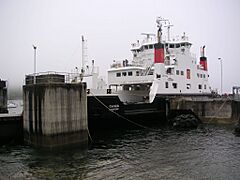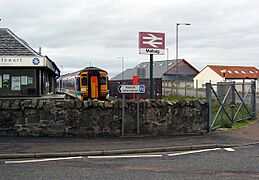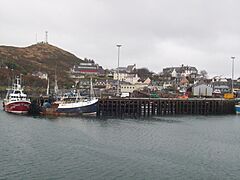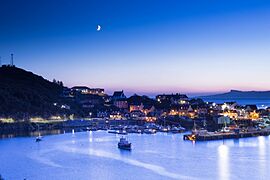Mallaig facts for kids
Quick facts for kids Mallaig
|
|
|---|---|
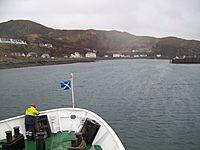 Approaching Mallaig harbour on the ferry from the Isle of Skye. |
|
| Population | 660 (2020) |
| OS grid reference | NM 67693 96810 |
| • Edinburgh | 124 mi (200 km) |
| • London | 444 mi (715 km) |
| Council area | |
| Lieutenancy area | |
| Country | Scotland |
| Sovereign state | United Kingdom |
| Post town | MALLAIG |
| Postcode district | PH41 |
| Dialling code | 01687 |
| EU Parliament | Scotland |
| UK Parliament |
|
| Scottish Parliament | |
Mallaig (![]() i/ˈmæleɪɡ/; Scottish Gaelic: Malaig [ˈmal̪ˠɛkʲ]) is a busy port town in the Highlands of Scotland. It is located on the west coast, facing the Isle of Skye across the Sound of Sleat. Mallaig is the final stop on the West Highland Line railway, which connects it to Fort William. You can also reach Fort William by road on the A830 road, also known as the "Road to the Isles".
i/ˈmæleɪɡ/; Scottish Gaelic: Malaig [ˈmal̪ˠɛkʲ]) is a busy port town in the Highlands of Scotland. It is located on the west coast, facing the Isle of Skye across the Sound of Sleat. Mallaig is the final stop on the West Highland Line railway, which connects it to Fort William. You can also reach Fort William by road on the A830 road, also known as the "Road to the Isles".
Contents
History and Growth of Mallaig
Mallaig started as a small village in the 1840s. A man named Lord Lovat owned the land. He divided a farm called Mallaigvaig into 17 smaller pieces. He then encouraged people to move there and become fishermen.
The town and its economy grew very quickly in the 1900s. This happened when the railway finally arrived.
Mallaig's Fishing Industry
Mallaig is a very important fishing port on the west coast of Scotland. In the 1960s, it was the busiest port in Europe for catching herring. Mallaig was famous for its delicious smoked kippers. These are herring fish that are traditionally smoked over oak wood. You can still find genuine oak-smoked kippers from a factory shop right on the harbour!
Ferries and Travel
Many ferries leave from Mallaig. They are operated by companies like Caledonian MacBrayne and Western Isles Cruises. You can take a ferry to:
- Armadale on the Isle of Skye
- Inverie in Knoydart (a very remote village)
- Lochboisdale on South Uist
- The beautiful Small Isles of Rùm, Eigg, Muck, and Canna
Mallaig and the areas around it are very popular places for holidays.
Languages Spoken
Most people in Mallaig speak English. However, some residents speak both English and Scottish Gaelic. The traditional Gaelic language is also taught at Mallaig Primary School for students who want to learn it.
Learning in Mallaig
Mallaig has great ways for people to learn, even from a distance. This means local people can take many different classes, from fun hobbies to university degrees. They can do this through Lochaber College and the UHI Millennium Institute.
Schools in Mallaig
Mallaig has its own primary school. Recently, students who learn through Gaelic from Lady Lovat Primary School in nearby Morar moved to Mallaig Primary. This helps Lady Lovat School focus more on its English-speaking students.
Mallaig also has a high school called Mallaig High School, which opened in 1989. This school serves students from Mallaig, the villages of Morar and Arisaig, the nearby Small Isles, and the Knoydart peninsula. Some students from the Small Isles stay in the school's hostel because they cannot travel home every day.
Things to Do and See
Mallaig has many places to eat, like restaurants, cafes, and takeaways. There is also a swimming pool and leisure centre run by the community. Most of these places are busiest during the summer when tourists visit. However, some, like the swimming pool, are open all year.
Mallaig has three hotels, many self-catering places, and several guest houses for visitors.
Shops and Services
In the village, you'll find a bank and three pubs. The main part of town is close to the harbour and the railway station. Most of the shops are on the main street or on Davies Brae. The swimming pool is located higher up in the village on Fank Brae.
You can find two small supermarkets and gift shops. There's also an art gallery that shows work by local artists, and a small bookshop.
Next to the railway station, there is a heritage centre. It has old photographs of the area, which is a great way to learn about Mallaig's history.
Mallaig has both Roman Catholic and Church of Scotland churches. There is also a Fishermen's Mission, which helps people who work at sea. You can find a small petrol station near the harbour, but it has limited opening hours.
Getting Around Mallaig
The West Highland Line railway was finished in 1901. It connects Mallaig railway station to Fort William, Oban, and Glasgow. In 2009, readers of a travel magazine voted this railway journey the best in the world! It was even ranked higher than the famous Trans-Siberian railway.
The train trip to Glasgow Queen Street railway station takes about five hours. You will see amazing scenery, including:
- Beautiful seascapes
- Lochs (lakes)
- Mountains and moorland
- Views of Loch Lomond
- Ben Nevis (the UK's highest mountain)
- Glenfinnan and Loch Eil
In the years before World War I, the amount of fish sold in Mallaig grew steadily. By 1914, it was worth over £60,000!
The Jacobite Steam Train
During the summer, the famous Jacobite steam train also visits Mallaig from Fort William. This is the train that was used as the Hogwarts Express in the Harry Potter movies!
Bus Services
Shiel Buses runs a service from Mallaig to Fort William. There are also buses that go south along the A861 road to the villages of Acharacle and Strontian.
Ferry Connections
Mallaig is a very important ferry port.
- Caledonian MacBrayne has regular services to Armadale on the Isle of Skye. This trip takes about 30 minutes.
- The MV Lord of the Isles ferry travels from Lochboisdale on South Uist to Mallaig. It then goes back and forth between Mallaig and Armadale.
- The MV Lochnevis ferry is specially built for the route to the Small Isles of Canna, Rùm, Eigg, and Muck. The schedule for this ferry changes each day.
There is also a local ferry service run by Bruce Watt. This ferry sails daily to Inverie in Knoydart, a very remote village. It can also stop at Tarbet in Morar if arranged beforehand. Tarbet can only be reached by sea. This service also offers a scenic cruise through Loch Nevis.
Mallaig in Movies
Mallaig and the railway line have been used in many films.
- The Harry Potter movies used the Mallaig railway line. The Hogwarts Express was often seen here during filming in the summer. Many other local areas were also used for filming locations.
- The 1996 movie Breaking the Waves was mostly filmed in Mallaig and the surrounding area.
- The beach scenes for the movie Local Hero were filmed a few miles south of Mallaig, at Morar and Arisaig.
Images for kids
See also
 In Spanish: Mallaig para niños
In Spanish: Mallaig para niños



